TotalEnergies Bundle
How Did a French Oil Company Become a Global Energy Powerhouse?
Delve into the TotalEnergies SWOT Analysis to understand its current standing, but first, journey back in time to explore the remarkable story of TotalEnergies. From its origins as a French oil company in 1924, TotalEnergies has navigated a century of global shifts, transforming from a national champion to a multi-energy giant. This brief history of TotalEnergies reveals a tale of strategic foresight, resilience, and a relentless pursuit of innovation.
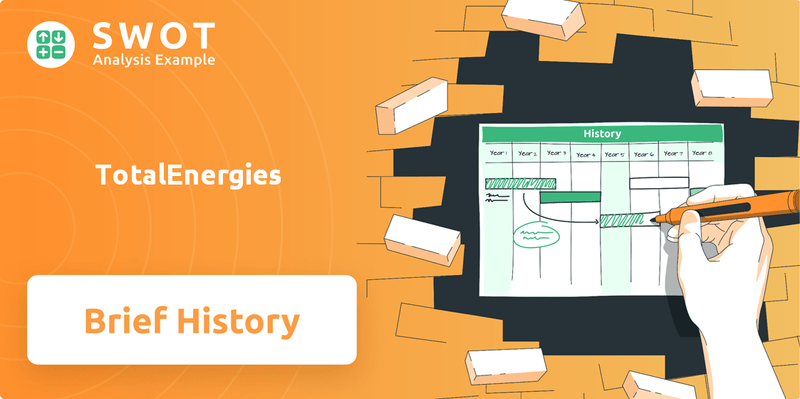
The TotalEnergies company journey, from its early days to its present-day status, is a testament to its ability to adapt and thrive amidst evolving global dynamics. Understanding the TotalEnergies history provides invaluable insights into the company's strategic decisions, including key acquisitions and expansions, its response to environmental concerns, and its evolving leadership. Examining the brief history TotalEnergies allows us to appreciate its evolution into a major player in the energy transition, aiming for carbon neutrality by 2050.
What is the TotalEnergies Founding Story?
The Marketing Strategy of TotalEnergies begins with its founding. TotalEnergies' history starts on March 28, 1924, in Paris. It was originally named Compagnie Française des Pétroles (CFP).
The French government and private investors created the company. This was in response to France's need for its own oil supplies. The goal was to reduce dependence on foreign companies after World War I. This need for energy independence was the driving force behind CFP's creation.
CFP's initial business model focused on finding and developing oil and gas reserves. In its founding year, CFP acquired Germany's confiscated shares in the Turkish Petroleum Company. This strategic move quickly placed the company in the international oil market. The company's creation was influenced by the geopolitical and economic conditions of the time. The focus was on national security through energy self-sufficiency.
TotalEnergies' origins trace back to 1924 in Paris, with the French government and private investors establishing Compagnie Française des Pétroles (CFP).
- CFP's primary objective was to secure France's oil supplies and reduce reliance on foreign entities.
- The company's initial acquisition of shares in the Turkish Petroleum Company immediately positioned it in the global oil market.
- The founding reflected a national strategy to ensure energy independence, driven by post-World War I geopolitical and economic contexts.
TotalEnergies SWOT Analysis
- Complete SWOT Breakdown
- Fully Customizable
- Editable in Excel & Word
- Professional Formatting
- Investor-Ready Format
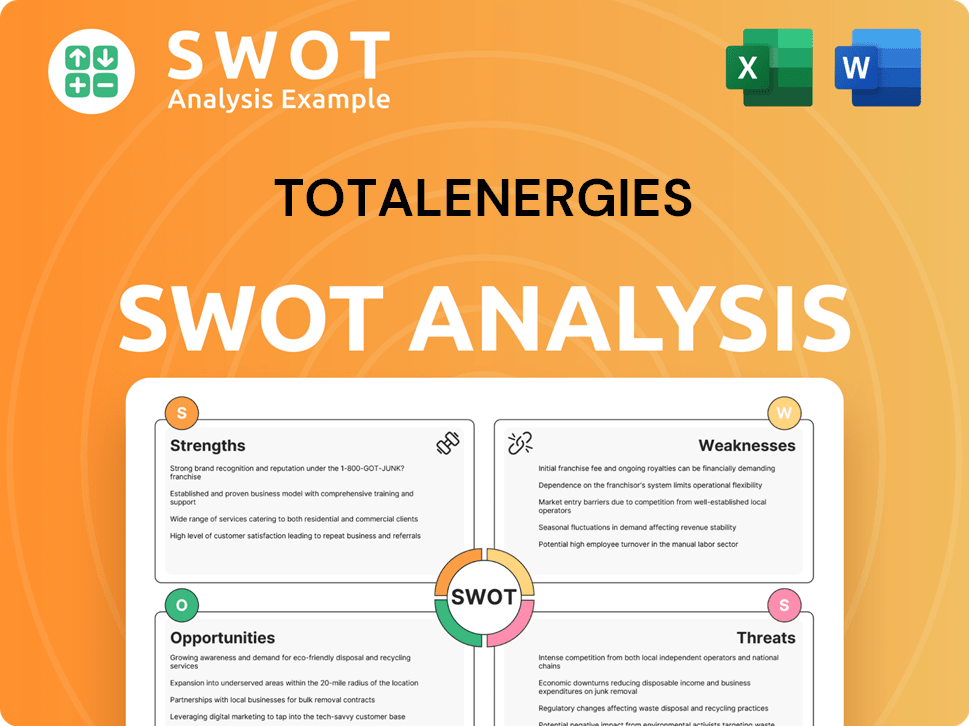
What Drove the Early Growth of TotalEnergies?
The early phase of the TotalEnergies company focused on expanding its exploration and extraction activities, primarily in the Middle East and Africa. This established it as a significant player in the global oil industry. By the 1950s, the company had grown to include oil refining and distribution. It also ventured into petrochemical production, solidifying its position as a major global oil company. The company's journey is a key part of the energy company history.
In its early years, the company, initially known as Compagnie Française des Pétroles (CFP), concentrated on exploration and extraction, mainly in the Middle East and Africa. This strategy helped it become a key player in the global oil market. By the 1950s, CFP had expanded to include oil refining and distribution, and it also entered petrochemical production.
A significant shift occurred in 1965 when the company rebranded from Compagnie Française des Pétroles to Total. This change reflected a broader focus beyond French petroleum. It signaled its emergence as a global energy company. This rebranding is a key milestone in the TotalEnergies history.
During the 1960s and 1970s, the company continued its expansion, becoming increasingly active in regions like West Africa, the Middle East, and the North Sea. This diversification broadened its geographical footprint. The TotalEnergies origins are rooted in this period of strategic growth.
The 1980s and 1990s were marked by significant mergers and acquisitions that reshaped the company. The 1999 merger with Fina and the 2000 acquisition of Elf Aquitaine, a French oil company, were pivotal. These moves significantly expanded its portfolio, enhancing its market position. You can learn more about the Target Market of TotalEnergies.
More recently, the company has expanded in low-carbon and renewable energy sectors. In 2024 and early 2025, acquisitions included VSB Group and SN Power. These acquisitions contribute to its target of 35 GW of gross renewable capacity by 2025 and over 100 TWh of electricity production by 2030.
In Q1 2025, TotalEnergies' hydrocarbon production exceeded 2.55 million barrels of oil equivalent per day, up 4% year-on-year. This growth benefited from project ramp-ups in Brazil, the United States, Malaysia, Argentina, and Denmark. The company's adjusted net income for Q1 2025 was $4.2 billion, with cash flow from operations at $7.0 billion.
TotalEnergies PESTLE Analysis
- Covers All 6 PESTLE Categories
- No Research Needed – Save Hours of Work
- Built by Experts, Trusted by Consultants
- Instant Download, Ready to Use
- 100% Editable, Fully Customizable
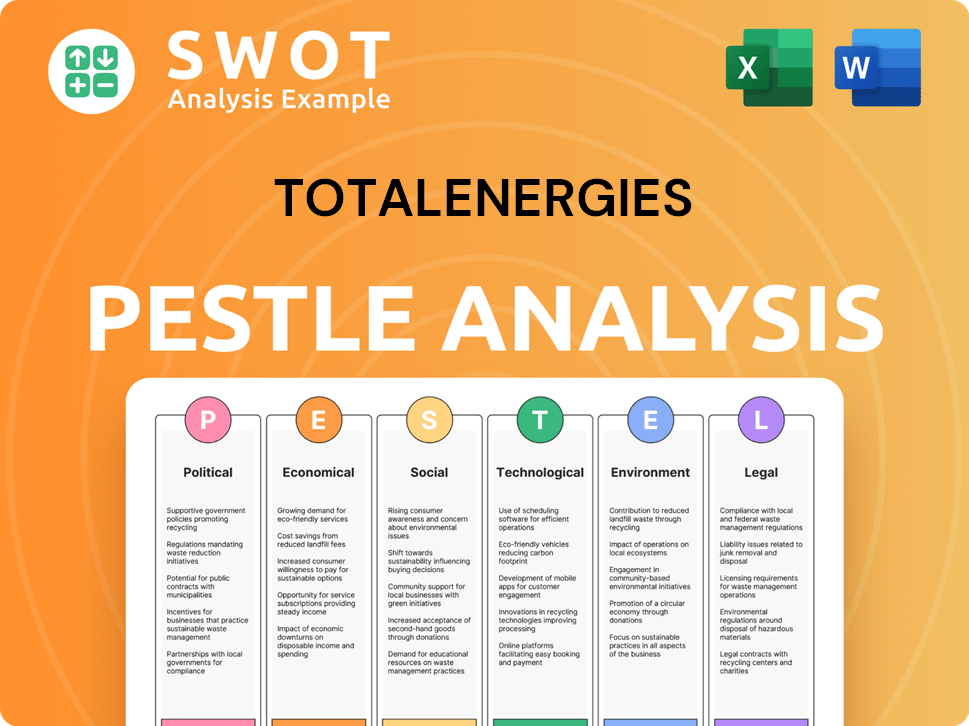
What are the key Milestones in TotalEnergies history?
The TotalEnergies history spans over a century, marked by significant achievements and considerable obstacles. The company's journey reflects the evolution of the energy sector, from its TotalEnergies origins to its current position as a multi-energy enterprise. The French oil company, formerly known as Total SA, has continually adapted to changing market dynamics and environmental concerns.
| Year | Milestone |
|---|---|
| 2021 | Rebranding to TotalEnergies, signaling a strategic shift towards a multi-energy company. |
| 2024 | Achieved a 55% reduction in methane emissions compared to 2020 levels, exceeding the 2025 target. |
| Early 2025 | Successful closure of acquisitions of VSB Group and SN Power. |
| May 2025 | Inauguration of the largest solar field in Europe in Spain. |
| Q1 2025 | Launched six new battery storage projects in Germany with a capacity of 221 MW. |
A major innovation is the strategic pivot towards a multi-energy company, highlighted by the 2021 rebranding. This rebrand reflects a commitment to providing affordable, reliable, and clean energy, with a focus on integrating renewables and electricity. TotalEnergies has demonstrated its adaptability by investing nearly $5 billion in low-carbon energies in 2024, with $4 billion in electricity.
TotalEnergies is actively expanding its renewable energy portfolio, aiming for 35 GW of gross renewable capacity by 2025. By the end of 2024, it had reached 26 GW of gross renewable electricity generation installed capacity.
The company has made strategic acquisitions to bolster its renewable energy capacity. Recent examples include the acquisitions of VSB Group and SN Power, which will enhance its position in wind, solar, and hydropower.
TotalEnergies is involved in projects to produce green hydrogen for European refineries. These initiatives, such as the Zeeland joint venture, aim to produce significant quantities of green hydrogen annually.
The company has launched battery storage projects to support its renewable energy initiatives. In Q1 2025, six new projects were initiated in Germany, adding a capacity of 221 MW.
TotalEnergies is investing in large-scale solar projects to increase its renewable energy production. The inauguration of its largest solar field in Europe in Spain in May 2025 is a key example.
TotalEnergies is committed to reducing its environmental footprint, with a focus on reducing methane emissions. The company exceeded its 2025 target in 2024, achieving a 55% reduction compared to 2020 levels.
Despite these achievements, TotalEnergies company has faced challenges such as market downturns and the complexities of the energy transition. The company's environmental impact history and human rights record in certain regions have also drawn scrutiny. To learn more about the company's financial structure and how it generates revenue, check out this article: Revenue Streams & Business Model of TotalEnergies.
The energy sector is subject to market fluctuations, which can impact the company's financial performance. TotalEnergies must navigate these uncertainties to maintain its profitability and growth.
The transition to cleaner energy sources requires significant investment and strategic adaptation. TotalEnergies is actively managing this transition by investing in renewables and low-carbon technologies.
The company faces scrutiny regarding its environmental impact and social responsibility. TotalEnergies addresses these issues through its sustainability strategy and emission reduction targets.
The company's operations are subject to geopolitical risks, which can affect its business. TotalEnergies must manage these risks through diversification and strategic planning.
TotalEnergies must balance the need to continue producing energy with the need to reduce industrial emissions. The company aims for zero methane emissions by 2030.
The company has made significant investments in low-carbon energies, such as solar and wind power. These investments are essential for its long-term sustainability and growth.
TotalEnergies Business Model Canvas
- Complete 9-Block Business Model Canvas
- Effortlessly Communicate Your Business Strategy
- Investor-Ready BMC Format
- 100% Editable and Customizable
- Clear and Structured Layout
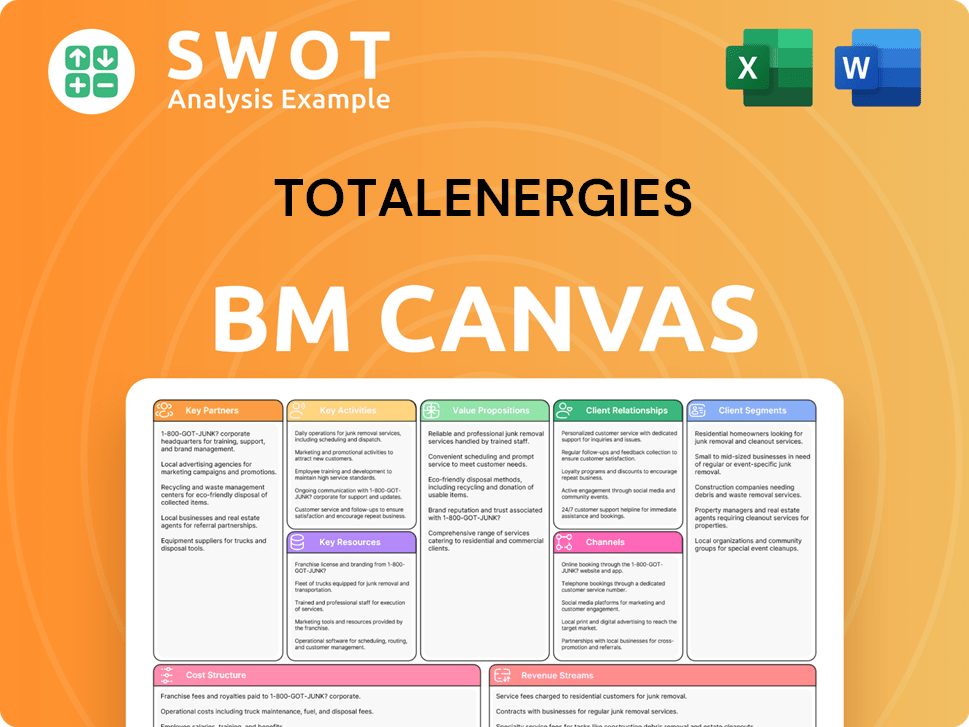
What is the Timeline of Key Events for TotalEnergies?
The Brief history of TotalEnergies, a major player in the energy sector, is marked by significant transformations and strategic shifts. From its origins as a French oil company to its current status as a global multi-energy firm, the company has consistently adapted to the evolving energy landscape. This evolution is reflected in its acquisitions, rebranding, and ambitious goals for a sustainable future.
| Year | Key Event |
|---|---|
| March 28, 1924 | Compagnie Française des Pétroles (CFP) was founded in Paris with the goal of securing France's energy independence. |
| 1927 | CFP started its oil production in Iraq, marking its early steps in the industry. |
| 1950s | The company expanded its operations to include oil refining, distribution, and petrochemical production. |
| 1965 | The company rebranded to Total, reflecting a broader global energy focus. |
| 1999 | Total merged with Fina, forming TotalFina. |
| 2000 | Total acquired Elf Aquitaine, strengthening its position as a major global oil and gas producer. |
| 2021 | The company rebranded to TotalEnergies, signaling its commitment to the energy transition and a multi-energy future. |
| 2023 | TotalEnergies signed a $27 billion energy agreement with Iraq to develop its energy sector. |
| December 2024 | The company acquired majority stakes in two offshore wind projects in Denmark, with a combined capacity of over 405 MW. |
| Q1 2025 | TotalEnergies reported an adjusted net income of $4.2 billion and CFFO of $7.0 billion; hydrocarbon production was above 2.55 Mboe/d, up 4% year-on-year. |
| April 2025 | TotalEnergies confirmed acquisitions of VSB Group (Europe) and SN Power (Africa), contributing to its 2025 renewable capacity target. |
| May 2025 | TotalEnergies inaugurated its largest solar field in Europe, located in Spain, and achieved first oil from the Mero-4 field in Brazil. |
TotalEnergies aims to achieve 35 GW of gross renewable capacity by 2025 and over 100 TWh of electricity production by 2030. The company plans to allocate $5 billion annually between 2025 and 2030 to low-carbon energy investments. This investment strategy is geared towards achieving a 12% return by 2030 in these activities.
The company is focused on reducing its Scope 1+2 emissions by 34% compared to 2015 levels and reducing methane emissions to less than 0.1% by 2030. TotalEnergies expects hydrocarbon production to grow by more than 3% in 2025 versus 2024. Key projects like Ballymore and Mero-4 will contribute to this growth, with the Sadada solar project in Libya also progressing.
TotalEnergies' CEO, Patrick Pouyanné, has reiterated the net investment guidance of $17 to $17.5 billion for 2025, with $4.5 billion dedicated to low-carbon energies. The company is actively pursuing a balanced multi-energy strategy, integrating hydrocarbons, especially LNG, with integrated power.
TotalEnergies aims to become a world-class player in the energy transition and achieve carbon neutrality by 2050. The company plans to contribute to 'eliminating' the equivalent of 100 Mt/year of CO2 generated by its customers by developing carbon utilization and carbon capture and storage solutions by 2050. This approach aligns with its founding vision of ensuring energy security in a sustainable future.
TotalEnergies Porter's Five Forces Analysis
- Covers All 5 Competitive Forces in Detail
- Structured for Consultants, Students, and Founders
- 100% Editable in Microsoft Word & Excel
- Instant Digital Download – Use Immediately
- Compatible with Mac & PC – Fully Unlocked
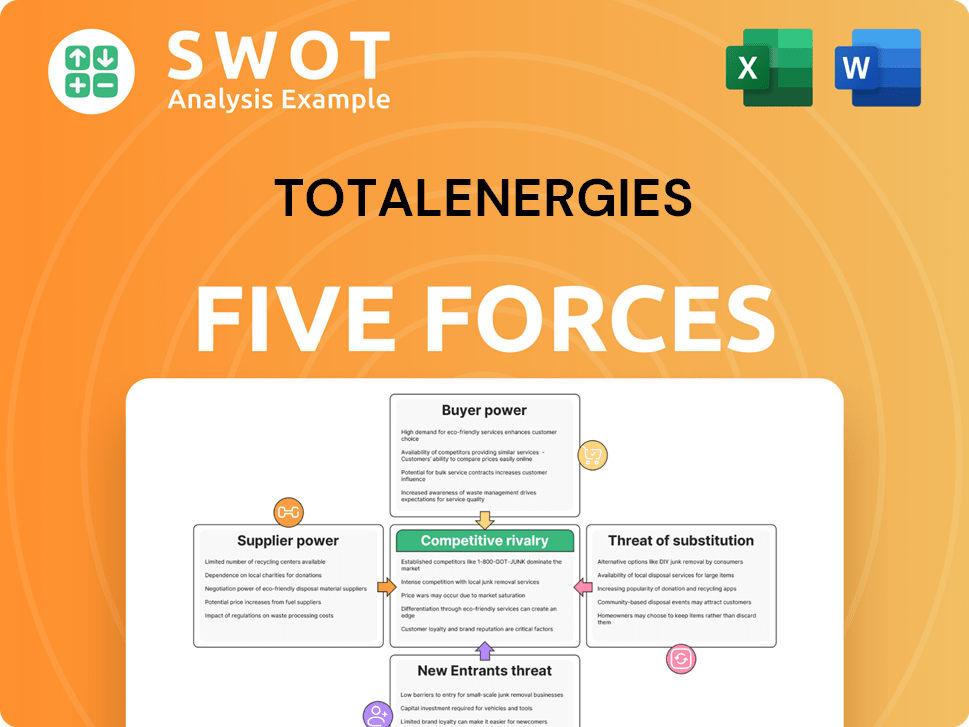
Related Blogs
- What is Competitive Landscape of TotalEnergies Company?
- What is Growth Strategy and Future Prospects of TotalEnergies Company?
- How Does TotalEnergies Company Work?
- What is Sales and Marketing Strategy of TotalEnergies Company?
- What is Brief History of TotalEnergies Company?
- Who Owns TotalEnergies Company?
- What is Customer Demographics and Target Market of TotalEnergies Company?
Disclaimer
All information, articles, and product details provided on this website are for general informational and educational purposes only. We do not claim any ownership over, nor do we intend to infringe upon, any trademarks, copyrights, logos, brand names, or other intellectual property mentioned or depicted on this site. Such intellectual property remains the property of its respective owners, and any references here are made solely for identification or informational purposes, without implying any affiliation, endorsement, or partnership.
We make no representations or warranties, express or implied, regarding the accuracy, completeness, or suitability of any content or products presented. Nothing on this website should be construed as legal, tax, investment, financial, medical, or other professional advice. In addition, no part of this site—including articles or product references—constitutes a solicitation, recommendation, endorsement, advertisement, or offer to buy or sell any securities, franchises, or other financial instruments, particularly in jurisdictions where such activity would be unlawful.
All content is of a general nature and may not address the specific circumstances of any individual or entity. It is not a substitute for professional advice or services. Any actions you take based on the information provided here are strictly at your own risk. You accept full responsibility for any decisions or outcomes arising from your use of this website and agree to release us from any liability in connection with your use of, or reliance upon, the content or products found herein.